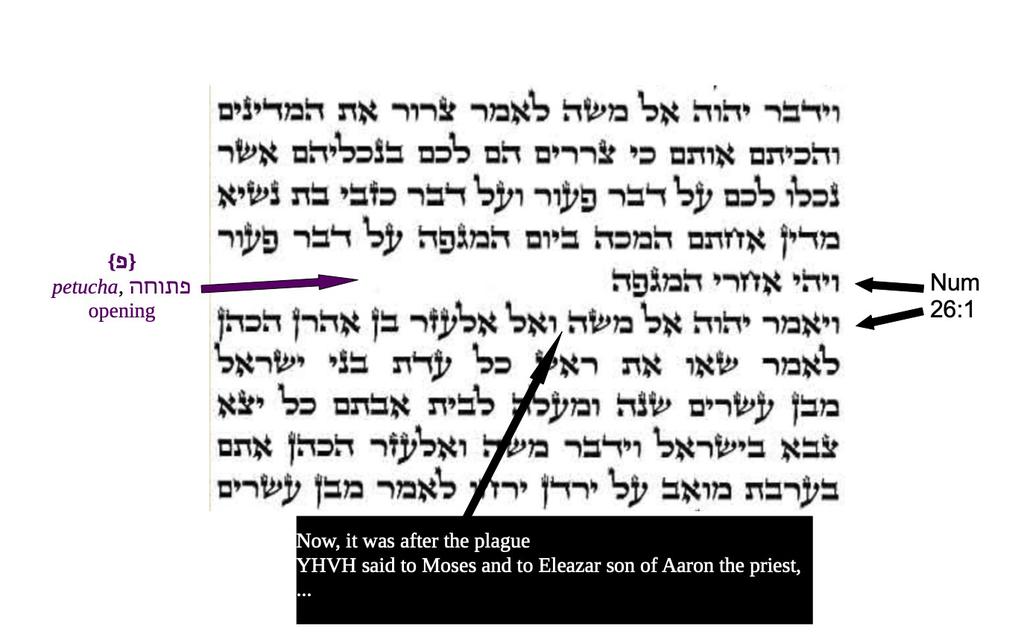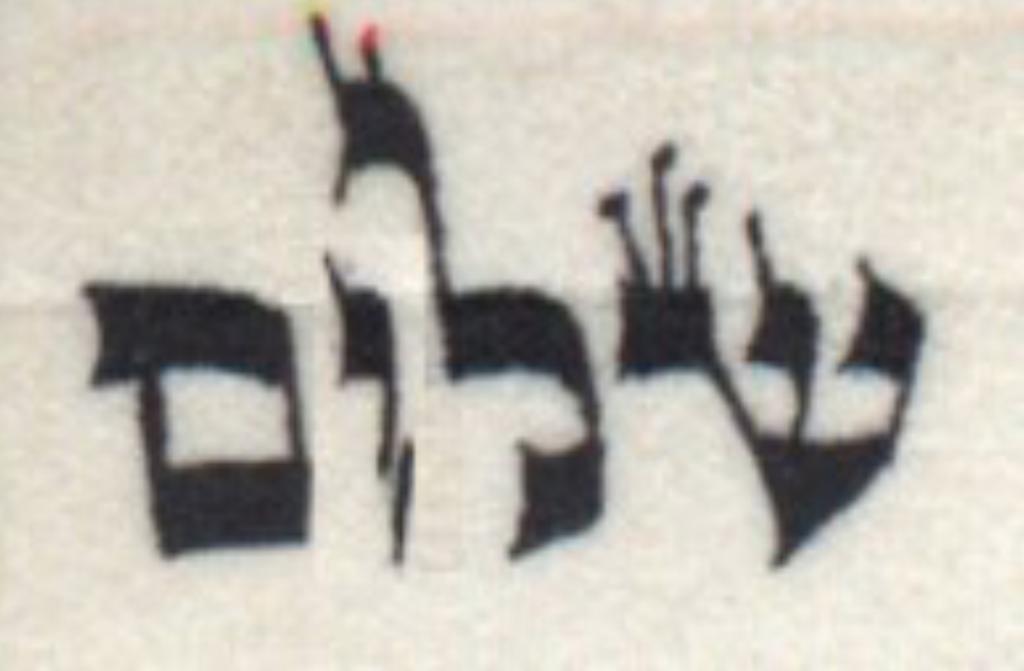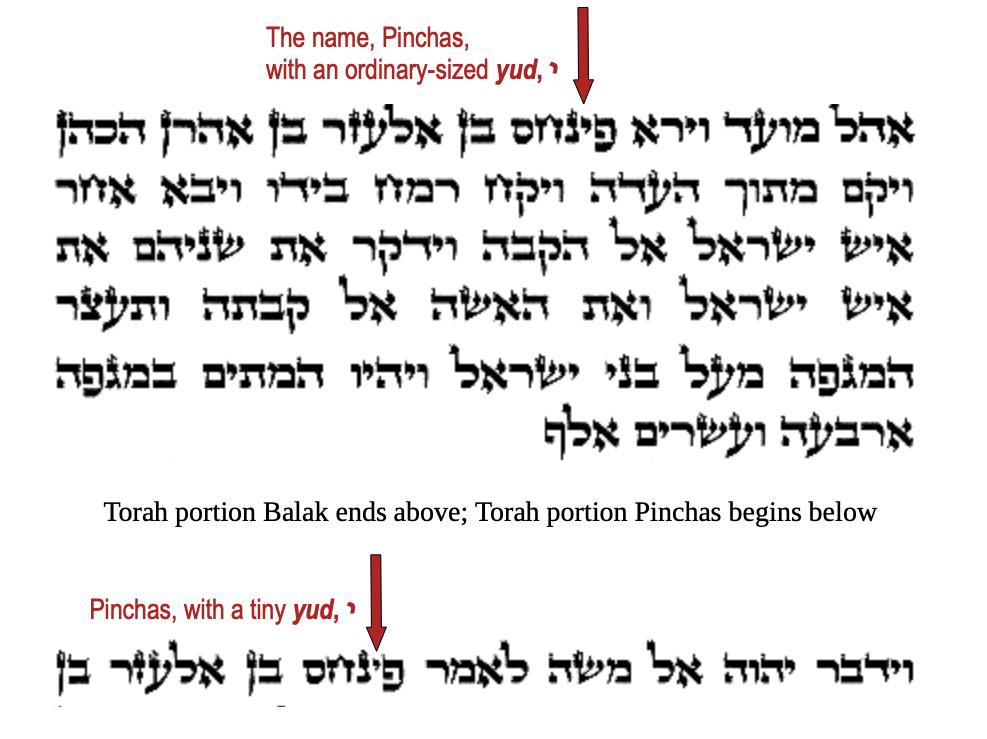The Torah portion (Numbers 25:10 - 30:1) named for Pinchas begins with a number of elements, including scribal oddities, creating distance in and around his story.
Portion Break
Major drama occurs in Numbers chapter 25. It starts unfolding with Num 25:1, when Yisrael is staying in "The Acacias," or in a place named Shittim. It wraps up in the last verse of the chapter, 25:18. However, the story is split between two portions: Balak, Num 22:2-25:9, and Pinchas.
It's an awkward split, not at any kind of natural spot -- no change of place or time or central character; on the other hand, it's not at what modern audiences would consider a cliffhanger, either. It has been explained in many ways, leading to all sorts of teachings over the centuries. Whatever its purpose or meaning, however, the break does serve to create distance within this story.
Narrative Break
An additional break occurs when the Book of Numbers moves on from the events around Pinchas at Shittim. Chapter 25 ends with God telling Moses that Yisrael should harass and strike the Midianites because of what just occurred:
(יח) כִּ֣י צֹרְרִ֥ים הֵם֙ לָכֶ֔ם בְּנִכְלֵיהֶ֛ם אֲשֶׁר־נִכְּל֥וּ לָכֶ֖ם עַל־דְּבַר־פְּע֑וֹר וְעַל־דְּבַ֞ר כׇּזְבִּ֨י בַת־נְשִׂ֤יא מִדְיָן֙ אֲחֹתָ֔ם הַמֻּכָּ֥ה בְיוֹם־הַמַּגֵּפָ֖ה עַל־דְּבַר־פְּעֽוֹר׃
(18) for they assailed you by the trickery they practiced against you—because of the affair of Peor and because of the affair of their kinswoman Kozbi, daughter of the Midianite chieftain, who was killed at the time of the plague on account of Peor.”
Then, in another odd break, that narrative is not continued for another five chapters. Chapters 26-30 take an entirely different route, focusing on administrative and ritual matters. Then, in Chapter 31, we return to this attack on Midian:
(א) וַיְדַבֵּר יהוה אֶל־מֹשֶׁה לֵּאמֹר׃
(ב) נְקֹם נִקְמַת בְּנֵי יִשְׂרָאֵל מֵאֵת הַמִּדְיָנִים אַחַר תֵּאָסֵף אֶל־עַמֶּיךָ׃
(ג) וַיְדַבֵּר מֹשֶׁה אֶל־הָעָם לֵאמֹר הֵחָלְצוּ מֵאִתְּכֶם אֲנָשִׁים לַצָּבָא וְיִהְיוּ עַל־מִדְיָן לָתֵת נִקְמַת־יהוה בְּמִדְיָן׃ (ד) אֶלֶף לַמַּטֶּה אֶלֶף לַמַּטֶּה לְכֹל מַטּוֹת יִשְׂרָאֵל תִּשְׁלְחוּ לַצָּבָא׃ (ה) וַיִּמָּסְרוּ מֵאַלְפֵי יִשְׂרָאֵל אֶלֶף לַמַּטֶּה שְׁנֵים־עָשָׂר אֶלֶף חֲלוּצֵי צָבָא׃ (ו) וַיִּשְׁלַח אֹתָם מֹשֶׁה...
GOD spoke to Moses, saying,
“Avenge the Israelite people on the Midianites; then you shall be gathered to your kin.”
Moses spoke to the people, saying, “Let troops be picked out from among you for a campaign, and let them fall upon Midian to wreak GOD’s vengeance on Midian.
So a thousand from each tribe were furnished from the divisions of Israel, twelve thousand picked for the campaign.
Moses dispatched them on the campaign...
As Chapter 26 begins, a scribal oddity interrupts the narrative in another way, with a mid-verse line break.
Verse Break
The basic format of Torah text is fully justified, filling the whole line right to left, except where tradition specifically calls for the scribe to leave an opening. These open lines are called "petucha [פתוחה]" in Hebrew and represented in digital format by a bracketed letter pei: {פ}.
Here's an example:
(ט) וַיִּהְי֕וּ הַמֵּתִ֖ים בַּמַּגֵּפָ֑ה אַרְבָּעָ֥ה וְעֶשְׂרִ֖ים אָֽלֶף׃ {פ}
(9) Those who died of the plague numbered twenty-four thousand.
Open lines are relatively common at the ends of chapters and other natural breaks. A petucha does not ordinarily appear in the middle of a verse, though.
But here, at the beginning of Chapter 26, tradition adds a mid-verse break, between "after the plague" and the census which takes place next:

Image description: A few lines of Torah script show an open space on one line -- stopping after three words, as for a new chapter or verse: "v'yehi acharei ha-mageifah [Now, it was after the plague]." On the next line, the verse continues: "va-yomer YHVH el moshe v'el eleazar ben aharon ha-cohein... [YHVH said to Moses and to Eleazar son of Aaron the priest...]." The open space is labeled "{פ}, petucha [פתוחה]."
This particular break is quite odd, if not unique. (Not sure of authoritative source to cite on this.) Like the other oddities described here, this has a number of explanations and teachings associated with it, different takes on the extra distance that rabbinic tradition has built into Pinchas's story.
Letter Break
Parashat Pinchas includes the only letter Torah scribes deliberately "break." In Num 25:12, God grants to Pinchas:
"...My pact/covenant [briti] of שלום."
The word "שלום" -- usually voiced "shalom" [peace]; sometimes "shalem" [whole]* -- is written in the Torah, in many** traditions, with a "broken vav."

Image description: Photograph of a single word, shin-lamed-vav-mem, from a Torah scroll, showing the vav cracked part-way down (some describe this unusual letter in three parts: a yud at the top; a thin space, about 2/3 way down; then, parallel to the space, a straight line -- overall impression being something like a broken broom-handle or spear-shaft).
*The "Old JPS" (1917) translation and several others use "peace" for this pact/covenant of שלום. JPS (Jewish Publication Society) translations since 1985 use "friendship." Torah Yesharah (1963) uses "full covenant." Fox (Schocken, 1995) leaves "shalom" untranslated.
**Yemeni scrolls, apparently, do not follow the "broken vav" tradition, and there are other variant traditions, according to this informative source.
Internal Space
In the portion named for him, Pinchas himself encompasses a bit of additional space. When his name appears most places in the Torah, the letters are of ordinary, uniform size. This includes the story at Shittim/Acacias, which starts with Num 25:1, in parashat Balak. But, at the start of the portion bearing his name, "Pinchas [פינחס -- pei-yud-nun-chet-samech]" is scribed strangely, with a yud about half usual size:

Image description: Illustrating relative size of the ordinary and smaller yud. Lines of text, as they would appear in a Torah scroll, from the end of the portion Balak and the beginning of the portion Pinchas; arrows point to the ordinary-sized yud in "Pinchas," as it appears in Balak, and then the half-size yud, in the same name, as it appears at the start of the next portion.
A number of teachings -- narrative, mystical, and/or ethical -- relate to the extra space created by using this smaller yud here.
Built-In Distance
The teachers and scribes who instituted these extra spaces had a variety of ideas -- sometimes contradictory ones -- to convey about this story and how we should relate to it. Later teachers used the existing oddities for yet more, different lessons.
Even teachers applauding Pinchas's actions/intentions seem eager to create some sense of distance from the violence involved. In what ways does the extra space give us room, maybe a bit of safe distancing, to consider how power and law and violence and fear work in- and outside Jewish traditions?
There's also a sense in which these breaks in the story, and in the text that conveys it, bring us into more immediate contact with life's inherent brokenness. In what ways might the annual call to embody the cracks of this story help us see opportunities for newness and repair?
In the context of the Three Weeks, how does parashat Pinchas, with its weird extra spaces, relate to what is missing in public life and and/or in need of repair?
More personally, do the cracks of the Pinchas tale suggest spots where we might need to open up, understand more about how power and law and violence and fear operate around, on, and through us?
----------------------------------------------------------
See also What Plague? Why? Then What? on this platform. More related material at SongEveryDay: Gathering Sources on Pinchas and Tammuz: For Times Such as These, excerpt from For Times Such as These: A Radical's Guide to the Jewish Year. Rabbi Ariana Katz and Rabbi Jessica Rosenberg. Wayne State University Press, 2024.





